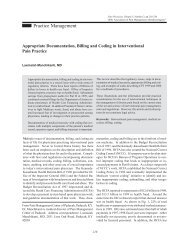ASIPP Practice Guidelines - Pain Physician
ASIPP Practice Guidelines - Pain Physician
ASIPP Practice Guidelines - Pain Physician
You also want an ePaper? Increase the reach of your titles
YUMPU automatically turns print PDFs into web optimized ePapers that Google loves.
Manchikanti et al • <strong>ASIPP</strong> <strong>Practice</strong> <strong>Guidelines</strong><br />
66<br />
evidence from well-designed trials without randomization,<br />
single group pre-post, cohort, time series, or matched case<br />
controlled studies. Level IV- limited is defined as evidence<br />
obtained from well-designed non-experimental studies<br />
from more than one center or research group. In addition,<br />
there is overwhelming support from respected authorities<br />
along with clinical evidence and descriptive studies in<br />
support of judicious use of trigger point injections.<br />
Spinal Cord Stimulation<br />
Spinal cord stimulation uses electrical stimulation of spinal<br />
cord to control pain. There are multiple theories regarding<br />
how this effect causes pain control, but the exact<br />
mechanism is still controversial and may be a result of more<br />
than one of these mechanisms. In the United States, the<br />
primary indications for spinal cord stimulation are failed<br />
back surgery syndrome (691, 692), and both sympathetically<br />
maintained and sympathetically independent pain of<br />
complex regional pain syndrome (693-696). However, in<br />
Europe, most interest in spinal cord stimulation has been<br />
in the treatment of chronic intractable angina and pain and<br />
disability due to peripheral vascular disease (697-701).<br />
Spinal cord stimulation, for the clinical control of pain,<br />
was first introduced in 1967 by Shealy et al (702), in response<br />
to the publication of the gate control theory of pain<br />
by Melzack and Wall in 1965 (703).<br />
In the field of spinal cord stimulation (SCS), as with other<br />
interventional techniques in chronic pain management,<br />
there are numerous retrospective studies that promote the<br />
efficacy of spinal cord stimulation, showing approximately<br />
60% efficacy that lasts approximately two years (691, 704-<br />
710). Wetzel et al (704) reviewed the current literature<br />
regarding the treatment of chronic pain in failed back surgery<br />
patients with spinal cord stimulation. Turner et al<br />
(69) also reviewed the literature on spinal cord stimulation<br />
in chronic low back pain in an attempt to perform a<br />
meta-analysis, concluding that this was not possible based<br />
on the characteristics of the literature. They analyzed 39<br />
reports, “all case studies”, concluding that 50% to 60% of<br />
patients with failed back surgery syndrome reported greater<br />
than 50% pain relief with the use of spinal cord stimulation.<br />
North et al (711), in a prospective study, randomized 27<br />
patients into repeat laminectomy or spinal cord stimulation<br />
groups. Even though this is not quite a similar treatment,<br />
the initial results were published after a 6-month<br />
follow-up; crossover between the groups was permitted.<br />
In this study, there was a significantly higher crossover<br />
rate from repeat laminectomy to spinal cord stimulation<br />
(67%) than vice versa (17%). Multiple observational studies<br />
in postlumbar laminectomy syndrome reported 25% to<br />
76% pain relief at various intervals (706-710, 712, 713).<br />
In a prospective, multicenter study of spinal cord stimulation,<br />
Burchiel et al (697) demonstrated its effectiveness in<br />
the management of chronic low back and extremity pain.<br />
The permanent stimulating system was implanted in 182<br />
patients. They reported at least 50% pain relief in 55% of<br />
the patients at 1-year follow-up.<br />
Kemler et al (695) evaluated spinal cord stimulation in<br />
patients with chronic reflex sympathetic dystrophy utilizing<br />
a randomized trial involving patients who had had reflex<br />
sympathetic dystrophy for at least 6 months. Thirtysix<br />
patients were assigned to receive treatment with spinal<br />
cord stimulation plus physical therapy, and 18 were assigned<br />
to receive physical therapy alone. The health-related<br />
quality of life improved in the 24 patients who actually<br />
underwent implantation of a spinal cord stimulator.<br />
Of the 24 patients, 6 had complications that required additional<br />
procedures, including removal of the device in one<br />
patient. Thus, at 6 months, spinal cord stimulation was<br />
successful in 20 of 36 patients (56%); however, since only<br />
24 patients received spinal cord stimulation, this is 20 out<br />
of 24 patients with an 80% success rate.<br />
Tesfaye et al (714) evaluated spinal cord stimulation for<br />
painful diabetic neuropathy in 10 patients who had not responded<br />
to conventional treatment. The electrode was<br />
implanted in the thoracic/lumbar epidural space. Immediate<br />
neuropathic pain relief after connecting the electrode<br />
was measured using a VAS, and exercise tolerance was<br />
assessed on a treadmill. Eight patients had statistically<br />
significant pain relief with an electrical stimulator, and the<br />
system was made permanent. Seven of these eight had<br />
statistically significant relief of pain at three months, and<br />
this relief was sustained in six patients until the end of the<br />
study at 14 months. These six patients used the stimulator<br />
as the sole treatment for their pain with improvement in<br />
their exercise tolerance. They claimed that electrical spinal<br />
cord stimulation offers a new and effective way of relieving<br />
chronic diabetic neuropathic pain, with improvement<br />
in exercise tolerance, in patients with neuropathic<br />
pain who do not respond to conventional treatment.<br />
In addition to the declining success rate, complications also<br />
are common (713). These were predominantly electrode<br />
related problems i.e., migration, fracture, etc. Infection<br />
was less common, even though it was reported in 5% of<br />
<strong>Pain</strong> <strong>Physician</strong> Vol. 4, No. 1, 2001
















